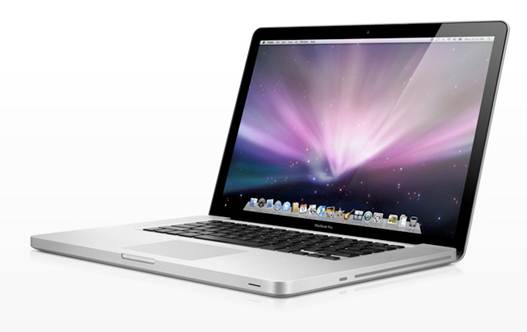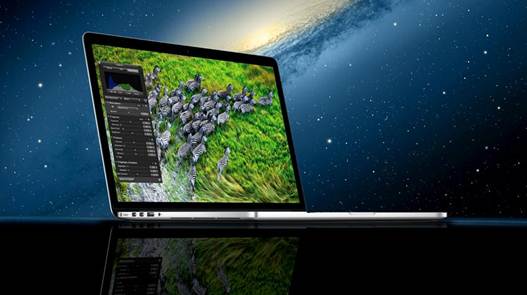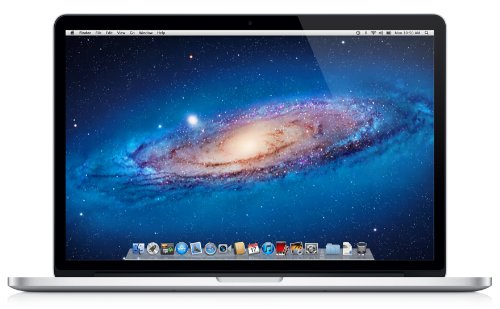MacBook Pro
The most recent MacBook Pros offer the same
unibody construction, backlit LED screen, lighted keyboard, multi-touch glass
trackpad and FaceTime HD webcam as the previous models, but push ahead with
updated internal architecture for improved performance.
The 154in MacBook Pro is less than an inch
thick, but its dimensions and heft more than compensate for its svelte frame,
and at least by Apple’s standards it’s a huge beast. The 13.3in model’s compact
dimensions and lighter frame will make a huge difference if you need to carry
your laptop around with you.
One reason for the extra weight is the
presence of a traditional hard drive. Spinning, platter-based drives have an
advantage in capacity and price, but they’re also slower and heavier than
flash-based storage. Apple uses its slowest hard drive speed 5,400rpm as the
default offering.

The
13.3in model’s compact dimensions and lighter frame will make a huge difference
if you need to carry your laptop around with you.
The 15.4in MacBook Pro offers a native
screen resolution of 1,440 x 900 pixels, along with nearly a dozen supported
resolutions, however, only the larger model lets you specially configure the
screen to a high-resolution 1,680 x 1,050 pixels, with the choice of either a
glossy or anti-glare display for an extra options are lower. Despite the lack of
Retina display, traditional MacBook Pros will note that its screens are still
extremely colourful, vibrant and pleasing.
Compared with their immediate predecessors
released late in 2011, the Mac Book Pro non-Retina line shows a modest
improvement in performance. According to Macworld’s lab tests, the low-end
15.4in 2.3GHz Core i7 model with 4GB of RAM came in with a Speed mark score of
221, (14 per cent faster than the previous low-end 154m model), with its 2.2GHz
Core 17 processor and 4GB of memory. Last year’s model scored 190 on the
benchmark test.
Gains for the latest 15.4in high-end 2.6GHz
Core i7 model with 8GB of memory were more restrained. That unit’s Speedmark
score hit 239, only eight per cent faster than the previous model, with its
2.4GHz Core i7 processor and 4GB of memory. Our Macworld lab tests found that
the new low-end 13.3in Mac Book Pro, with a Speedmark score of 161, clocked
nine per cent faster than the previous low-end model, which scored 146. The new
high-end 13.3in Mac Book Pro, with a Speedmark score of 189, is 15 per cent
faster overall than its predecessor, which scored 164 on the benchmark.

Gains
for the latest 15.4in high-end 2.6GHz Core i7 model with 8GB of memory were
more restrained.
The 13.3in MacBook Pro is available with a
2.56Hz dual-core Intel Core i5 processor, 4GB of memory and 500GB hard drive
starting at $1498.5, and with a 2.9GHz dual-core Intel Core i7 processor, 8GB
of memory and 750G B hard drive starting at $1,873.5. The 15.4in model is
available with a 2.3GHz quad-core Intel Core i7 processor, 4GB of memory, Intel
HD Graphics 4000 and Nvidia GeForce GT 650M, and 500G B hard drive starting at
$2,248.5; and with a 2.6GHz quad-core Intel Core i7 processor, 8GB of memory,
Intel HD Graphics 4000 and Nvidia GeForce GT 650M, and 750GB hard drive
starting at $2,698.5.
Configure to order options include faster
quad-core processors up to 2.7GHz, additional hard drive capacity up to 1TB, up
to 8GB of memory and solid $120. For the 13.3in model, the resolution on the
benchmark, state storage up to 512GB.
MacBook Pro With Retina Display
A like the regular 15.4in model, and the aluminium
body design is essentially the same. The major difference is the thickness.
With the lid closed, this MacBook Pro measures 1.8cm, while the regular 15.4in
laptop is much thicker. The thin profile of the Retina MacBook Pro aids
portability and means this model is lighter than the standard MacBook Pro.
Note: It looks likely that Apple will soon launch a 13m Retina display model.
It weighs 2.02kg, which is just over 500g
lighter than the regular 15.4in model. Of course, lighter is better, but what’s
impressive is that its weight feels evenly distributed, although it’s a little
heavier towards the screen.

A
like the regular 15.4in model, and the aluminium body design is essentially the
same. The major difference is the thickness.
The marquee feature of this laptop is right
in the name the Retina display. Its numbers are truly mind-boggling: 2,880 x
1,800 pixels for a total of 5.18 million pixels on a 154m backlit screen. When
set at the (Best) Retina setting, it’s spectacular the detail in photos is
great, and text is the crispest and cleanest it’s ever been. With so many
pixels, it’s easy to appreciate the fine details of high-resolution photos, but
it emphasises the low quality of many website images. Videos also look
excellent, and to display a 1080p movie on this system, films are enlarged to
fill the screen, since these laptops have more pixels than an HDTV.
This MacBook has two video cards one
integrated, one discrete. The integrated video card is Intel’s HD Graphics
4000, which is used to help preserve battery life. The other is Nvidia’s Ge
Force GT 650M, with 1GB of video memory. The system automatically switches
processors based on the activity you’re performing, so you’re not sacrificing
performance while, say, playing a game. You can turn off automatic graphics
switching, which then sets the Retina MacBook Pro to always use the discrete
video card.
In its ongoing effort to ease choices,
Apple has revamped the Displays system preference for the Retina MacBook Pro.
There are only five choices on a scale, which makes it much easier to find a
comfortable resolution setting.
Impressively, in Macworld’s Lab tests, the
2.6GHz Core i7 Retina MacBook Pro isn’t just the fastest laptop we’ve tested,
it’s the fastest Mac we’ve tested, posting a remarkable 330 SDeedmark 7 score.
The 2.3GHz Core i7 model isn’t far behind, with a score of 319. Compared to the
latest regular MacBook Pros, the Retina systems see serious gains in disk-based
activities. In tests where the storage device comes into play, the Retina
laptops held an advantage. In other tests that aren’t so disk dependent and
more CPU focused, the Retina laptops and the new regular models were within
range of each other. The one test where the recent regular MacBook Pros clearly
pulls away from the Retina laptops is in our Portal 2 frame rate test. Retina
displays have so many more pixels to push that it can affect the frame rate in
games.

Retina
displays have so many more pixels to push that it can affect the frame rate in
games.
The 15.4in MacBook Pro is available with a
2.3GHz quad-core Intel Core i7 processor, with Turbo Boost speeds up to 3.3GHz,
8GB of memory and 256GB of flash storage starting at $2698.5; and with a 2.6GHz
quad-core Intel Core i7 processor with Turbo Boost speeds up to 3.6GHz, 8GB of
memory and 512GB of flash storage starting at $3448.5. Configure-to-order
options include faster quad-core processors up to 2.7GHz, up to 16GB of memory
and flash stora2e up to 768GB.